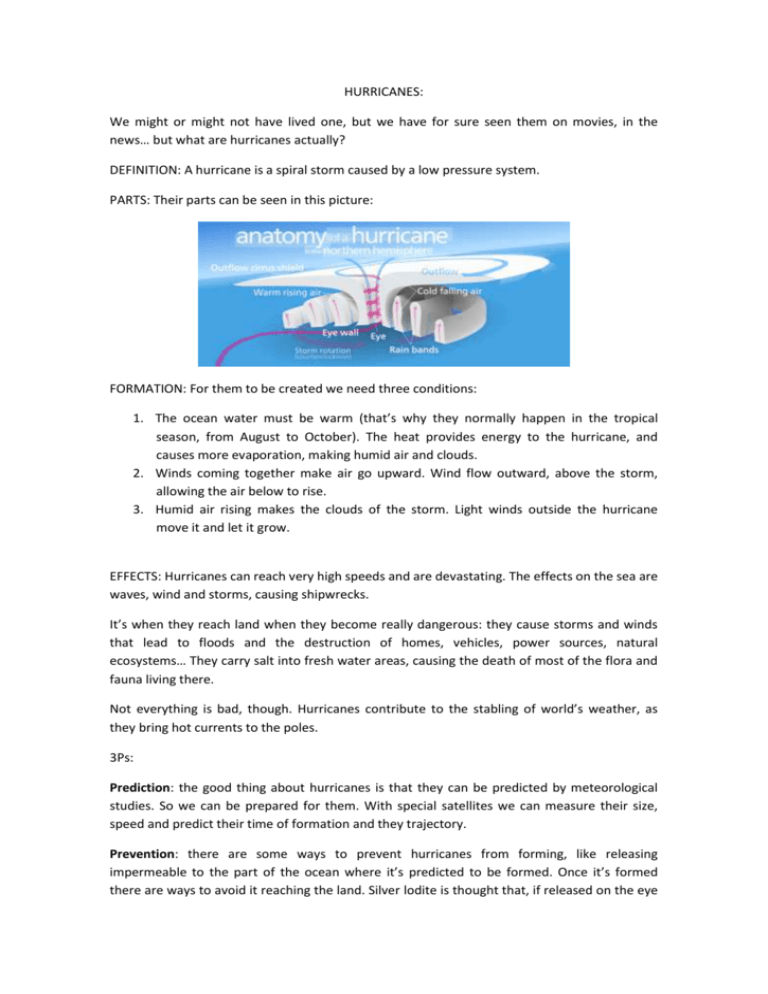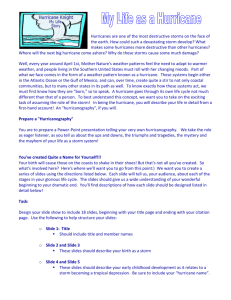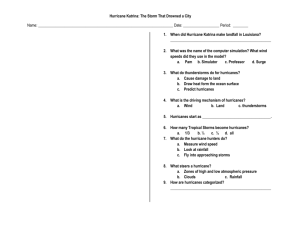HURRICANES: We might or might not have lived one, but we have
advertisement

HURRICANES: We might or might not have lived one, but we have for sure seen them on movies, in the news… but what are hurricanes actually? DEFINITION: A hurricane is a spiral storm caused by a low pressure system. PARTS: Their parts can be seen in this picture: FORMATION: For them to be created we need three conditions: 1. The ocean water must be warm (that’s why they normally happen in the tropical season, from August to October). The heat provides energy to the hurricane, and causes more evaporation, making humid air and clouds. 2. Winds coming together make air go upward. Wind flow outward, above the storm, allowing the air below to rise. 3. Humid air rising makes the clouds of the storm. Light winds outside the hurricane move it and let it grow. EFFECTS: Hurricanes can reach very high speeds and are devastating. The effects on the sea are waves, wind and storms, causing shipwrecks. It’s when they reach land when they become really dangerous: they cause storms and winds that lead to floods and the destruction of homes, vehicles, power sources, natural ecosystems… They carry salt into fresh water areas, causing the death of most of the flora and fauna living there. Not everything is bad, though. Hurricanes contribute to the stabling of world’s weather, as they bring hot currents to the poles. 3Ps: Prediction: the good thing about hurricanes is that they can be predicted by meteorological studies. So we can be prepared for them. With special satellites we can measure their size, speed and predict their time of formation and they trajectory. Prevention: there are some ways to prevent hurricanes from forming, like releasing impermeable to the part of the ocean where it’s predicted to be formed. Once it’s formed there are ways to avoid it reaching the land. Silver lodite is thought that, if released on the eye of the hurricane, it would reduce its power and cause it to stop. This could be achieved because it forms moisture that separates the hurricane. Preparation: when you see yourself in a hurricane, there are some safety precautions to follow: 1. 2. 3. 4. 5. 6. Bring in anything that can be picked up by the wind (bicycles, furniture). Close your windows and doors. Turn off your propane tank and your light source. Create a hurricane evacuation plan and practice drills. Fins all about your communities hurricane response plan and local shelters. Obey evacuation orders and avoid flooded areas (bridges, roads). CLASIFICATION Hurricanes are measured in categories depending on their speed. The faster a hurricane is, the greater the damage it causes. These are the most destructive hurricanes the world has ever seen. They have all occurred in North America. Hurricane Rita I Sandy might sound familiar to you. Hurricane Mitch is the one that has caused the most deaths, even if it wasn’t the highest in category. It affected South Florida, a very populated area, not like the others, that affected not highly populated areas. The most destructive hurricane ever was Katrina. On August 2005, Katrina struck the gulf coast of the USA. It was a category 3 hurricane on the SS (Saffir Sympson) scale. It caused winds of 100-140 k/hour and stretched 400 miles across, creating a great damage. It caused massive flooding, 1833 deaths and 125 billion US dollars of economic impact. The most recent hurricane with devastating effects is hurricane Irene. It wasn’t a super strong hurricane, but it was terribly destructive, as it passed through NYC, and destroyed buildings, enterprises, power houses, leaving the city isolated and without electricity. It happened on August2005. It was a category 1 hurricane that was created on the Atlantic Ocean and stretched though Cuba,, Florida, NY and reached Canada. It caused 45 deaths and more than 73 billion dollar damages. In NY there was no power during the storm, which lasted for more than a day, creating a great impact on enterprises and businesses of the city. NAMING: There are six lists of names that rotate every six years. The only time that there is a change in the lists is if a storm is so deadly that it can be inappropriate to reuse de name of the hurricane in future ones. CURIOSITIES: Even if hurricanes can be very destructive, they are beautiful to watch from a distance. There are people whose job is to follow hurricanes and storms to take beautiful pictures and videos. These people are called “storm chasers”. Hurricanes named after women tend to build in pressure as the days go by, finally exploding into rage. Hurricanes named after men are shorter in duration, but never seem to be aware of how much pain they cause.






